

2/2006

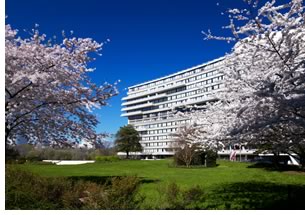 by Russell Boniface
by Russell Boniface
Associate Editor
The Watergate Hotel in Washington, D.C., part of a mixed-use complex adjacent to the Kennedy Center and overlooking the Potomac River, will undergo a renovation that will transform the 13-story, 251-room property into 96 world-class luxury residences. Washington D.C.-based developer Monument Realty has hired the Dallas and Washington D.C.-based architecture firm ForrestPerkins to be the lead interior design architecture firm on the project. The Watergate Hotel’s luxury residences are expected to be completed by summer 2007.
 Contemporary expression to ’60s curves
and angles
Contemporary expression to ’60s curves
and angles
The Watergate Hotel will be renamed The Watergate and turned into luxury
residences that will range in price from $650,000 for a one-bedroom
to more than $9 million for a three-bedroom penthouse. The residences
will range in size from 800 to more than 5,400 square feet, and all
units will have views of the Potomac River.
Michael J. Darby, cofounder and principal at Monument Realty, says that the Watergate property is a developer's dream. “The Watergate Hotel is a landmark property and we are eager to transform it into a world-class residence that will feature some of the city’s most distinctive and luxurious housing.”
The curved exterior of The Watergate Hotel is not being altered; only the interior will be reconfigured. Stephen Perkins, AIA, cofounder and principal of ForrestPerkins, is the lead interior design architect on the Watergate project. His firm specializes in luxury interior design for hotels and residences. Perkins says that the renovation will lend contemporary expression to the 1960s curvilinear design of European Modernist architect Luigi Moretti.
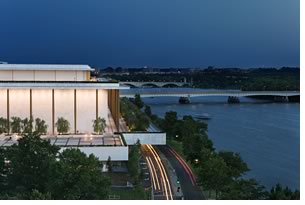 “Moretti’s Watergate complex has been a significant landmark
in my life, both personal and professional, for many years,” explains
Perkins. “The opportunity for ForrestPerkins to convert this historied
hotel to luxury residences is truly an honor. Washington is currently
enjoying an enormous boom in residential development, and the Watergate
represents a pivotal project in this trend.” Washington D.C.-based
interior design firm Hickok Warner Cole Architects and Toronto-based
interior design firm Yabu Pushelberg are also working on the project.
“Moretti’s Watergate complex has been a significant landmark
in my life, both personal and professional, for many years,” explains
Perkins. “The opportunity for ForrestPerkins to convert this historied
hotel to luxury residences is truly an honor. Washington is currently
enjoying an enormous boom in residential development, and the Watergate
represents a pivotal project in this trend.” Washington D.C.-based
interior design firm Hickok Warner Cole Architects and Toronto-based
interior design firm Yabu Pushelberg are also working on the project.
The curved and angled buildings that compose the Watergate complex are situated on a 10-acre triangular site. There are six buildings: a hotel, two office buildings, and three luxury apartment buildings with more than 600 apartments and penthouses. The Watergate Hotel opened in 1967. It is connected to the Watergate Office Building, both coming together to form a T-shape, with the stem of the T being the hotel. The two buildings are connected on all floors.
Monument Realty purchased the property in August 2004 from a partnership controlled by Blackstone Real Estate for an estimated $55 million. In addition to the hotel, the Watergate complex has a shopping mall that includes upscale shops such as Saks Jandel, Valentino, and Yves Saint-Laurent.
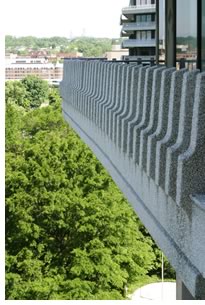 Geometry brings land and water together
Geometry brings land and water together
The Watergate complex was designed and constructed between 1964 and 1971
and is significant as an innovative example of “D.C. Modern” in
a city dominated by traditional Classicism. Watergate represents the
only example of Moretti’s work in the U.S., and the complex received
historic-landmark status in February 2004.
The triangular site is adjacent to the Potomac River, Rock Creek and Potomac parkways, and Rock Creek Park itself in the Foggy Bottom neighborhood. Moretti called this site “one of the best, if not the best, in Washington.” Buildings take different geometric concrete shapes, such as an ellipsis, a polygon, and a rhombus, generating a unique architecture of curves and angles that, together, seem to cruise into the Potomac. The irregularly staggered concrete balconies suggest the decks of a cruise ship. The large, metal-framed windows capture the riverine views. The Watergate West apartment building has a sharp, dramatic projecting corner “bow” at its north end. The heights of the buildings range from 11 to 14 stories, with some upper levels recessed. Mechanical systems on the roofs are disguised by cylindrical, concrete walls—some of which are elliptical—generating a smokestack look, capping the cruise ship effect.
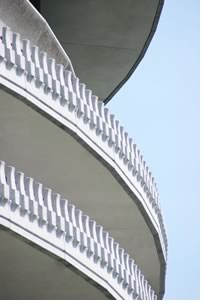 The curvilinear shapes of the buildings also complement the river and
winding parkland. The design required an engineering firm to make measurements
for the shapes and angles with a computer, one of the earliest known
uses of computer-aided architectural design, as well as for the 8,000
square feet of irregular windows and 2,200 irregular wall panels. No
two floors have a facade exactly alike. Other significant designers employed
at Watergate included acclaimed Washington landscape architect Boris
Timchenko, who executed gardens for many prominent Washington residents,
and noted sculptor and muralist Pietro Lazzari.
The curvilinear shapes of the buildings also complement the river and
winding parkland. The design required an engineering firm to make measurements
for the shapes and angles with a computer, one of the earliest known
uses of computer-aided architectural design, as well as for the 8,000
square feet of irregular windows and 2,200 irregular wall panels. No
two floors have a facade exactly alike. Other significant designers employed
at Watergate included acclaimed Washington landscape architect Boris
Timchenko, who executed gardens for many prominent Washington residents,
and noted sculptor and muralist Pietro Lazzari.
Designed to be a planned urban community, with mixed-uses such as an office, hotel, and co-ops, as well as green space, shops, and amenities, the Watergate, when opened in 1967, was described as a town within a city. Despite being considered mixed-income at first, the reality was that it was geared for the affluent. When built, 150 floor plans were offered, ranging from duplexes to penthouses, some going as high as 5,000 square feet. Interior elements included marble floors, Italian murals, entrance foyers, columns, and even servants’ quarters. Enormous balconies with scenic views and elaborate rooftop gardens were the exterior perks, as was the open green space below. Peace and quiet from the din of Washington and high-end shops such as Gucci only reinforced the sense of an affluent clientele.
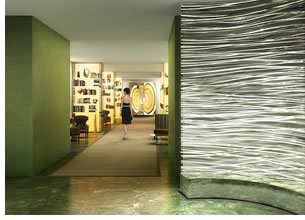 A unique residential experience
A unique residential experience
Francis Durkin, an associate at Washington, D.C.-based Hickok Warner
Cole Architects, says it has been a challenge expanding and renovating
the Watergate Hotel’s curved, 16-foot column-bay spacing—with
its thin-plate concrete—into co-op suites. “In the biggest
sense, a typical floorplate has 25 hotel rooms today. We are converting
that to nine units. Since it was built 40 years ago as a hotel, you
can imagine that none of the infrastructure is reusable. It’s
currently heated by fan-coil perimeter through-wall units,
like every hotel, which is inappropriate for a luxury residence. The
plumbing stacks are made only for bathrooms, not kitchens, and they
are all in the wrong place.”
“We are cutting new holes for new ductwork and plumbing, since we can’t brace it with steel the way we normally would,” Durkin continues. “For this, we designed carbon-fiber reinforcing, a tape that we use to reinforce the holes that we are cutting. We’ve had to punch a lot of new holes. We are trying to preserve the high ceilings as much as possible, given that the slab-to-slab is pretty short. We are going to replace all the windows to match the existing frame, upgrade their thermal and acoustical performance, repair the pre-cast pieces, and replace a lot of the railings. It is challenging, but, on the other hand, that is what is going to make it a unique residential experience.”
 Units will feature floor-to-ceiling windows that will ensure that every
residence enjoys panoramic Potomac River views. They will also boast
architectural details such as Poggenpohl cabinetry; Dornbracht bathroom
fixtures; exotic stone and premium hardwood surfaces; and upscale appliances
by SubZero, Viking, and Bosch. In addition, residents will enjoy community
rooms, a roof terrace, ample parking, a state-of-the-art health club
and spa, a new restaurant, community and meeting rooms, and an indoor
swimming pool. Blackstone will continue to operate the hotel over the
next year until final details of the conversion are complete.
Units will feature floor-to-ceiling windows that will ensure that every
residence enjoys panoramic Potomac River views. They will also boast
architectural details such as Poggenpohl cabinetry; Dornbracht bathroom
fixtures; exotic stone and premium hardwood surfaces; and upscale appliances
by SubZero, Viking, and Bosch. In addition, residents will enjoy community
rooms, a roof terrace, ample parking, a state-of-the-art health club
and spa, a new restaurant, community and meeting rooms, and an indoor
swimming pool. Blackstone will continue to operate the hotel over the
next year until final details of the conversion are complete.
The new Watergate will get a new neighbor
Darby explains that Monument Realty declined to purchase the 11-story
Watergate Office Building, site of the famous 1972 burglary, when Trizec
Properties Inc. of Chicago sold it last October. That sale eventually
went to BentleyForbes, a Los Angeles real estate company, for $86.5
million. Adjacent to the Watergate Hotel, the office building forms
the top of the overall T-shaped plan.
 Also noteworthy because of the curiosity of its design, the Watergate
Office Building has a rhombus footprint, amid all the surrounding curvilinear
design. It has no balconies, unlike the “toothy” curved and
staggered balconies of the Watergate apartments. Perhaps its most interesting
architectural feature is the three-faceted protruding bay facade that
juts out about a third of the way from each end of the building. And
the bay is recessed on the sixth, seventh, and top floors, which Moretti
configured to maximize interior daylight. BentleyForbes is planning interior
renovations at an estimated cost of less than $5 million but has stated
it plans to maintain the original aesthetics of the building.
Also noteworthy because of the curiosity of its design, the Watergate
Office Building has a rhombus footprint, amid all the surrounding curvilinear
design. It has no balconies, unlike the “toothy” curved and
staggered balconies of the Watergate apartments. Perhaps its most interesting
architectural feature is the three-faceted protruding bay facade that
juts out about a third of the way from each end of the building. And
the bay is recessed on the sixth, seventh, and top floors, which Moretti
configured to maximize interior daylight. BentleyForbes is planning interior
renovations at an estimated cost of less than $5 million but has stated
it plans to maintain the original aesthetics of the building.
It was the Watergate Hotel that appealed to Darby to create luxury residences, though. “The highest and best use of this building is not a hotel. It was a no-brainer. It was worth it in the end,” he says.
Copyright 2006 The American Institute of Architects.
All rights reserved. Home Page ![]()
![]()
Did
you know . . .
• Luigi Moretti worked for the Italian firm Società Generale
Immobiliare (SGI), which purchased the plot of land for Watergate on the
defunct Chesapeake and Ohio Canal in the early 1960s. The last lock, which
diverted water from the Potomac River into the Tidal Basin, was known as
the "water gate."
• Watergate VIP residents have included Bob and Elizabeth Dole, Supreme
Court Justice Ruth Bader Ginsberg, and Paul O’Neill. Current Secretary
of State Condoleezza Rice now lives there.
• The makers of Forrest Gump filmed the scene in which Gump meets
President Nixon in the Watergate complex.
• There is a Watergate salad. No one knows how it got that name. Kraft
developed the recipe for Pistachio Pineapple Delight in 1975 along with
its new pistachio pudding mix. Kraft never suggested serving the dessert
as a salad or changing the name and didn't refer to it at all as Watergate
Salad until consumers started requesting a recipe for Watergate Salad.
The recipe is pistachio pudding, crushed pineapple, miniature marshmallows,
whipped cream, and chopped nuts, preferably pecans.
• Cher once crooned in the hotel lobby.
• Watergate salon owner Zahira Zahir has coiffed the hair of three
presidents—Ronald Reagan, George H.W. Bush, and George W. Bush—as
well as First Lady Barbara Bush and actress Jaclyn Smith.
![]()